From main course and snacks to desserts – sago or sabudana is a versatile ingredient that is used to make a variety of dishes and has many uses in Indian cuisine. It is also a favorite of us Indians, especially during the Hindu fasting or vrat season. While you may crush over the regular khichdi and vada made with sabudana, here’s an Indian dessert made with it, which is all things delish. Sabudana Kheer, the sweet pudding made with sago pearls, milk and sugar is also a popular pick as fasting food during the Hindu Navratri Festival. Simple and easy to make, and absolutely delicious.
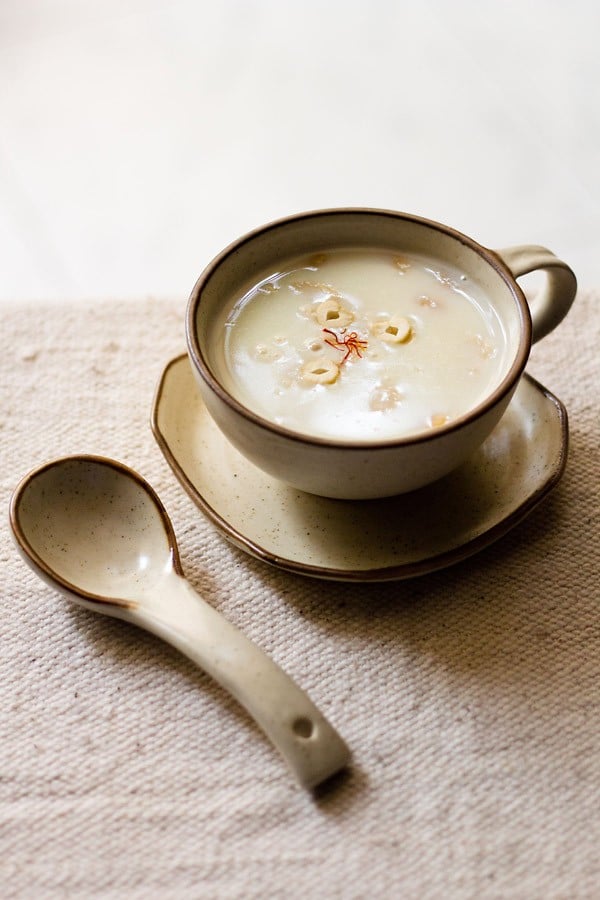
Table of Contents
About Sabudana Kheer
Like I mentioned earlier, Sabudana Kheer is basically an Indian sweet pudding, in which the main ingredient is sago or tapioca pearls (sabudana).
In addition to this, it also has whole milk, sugar and flavorings like green cardamom powder, nuts and saffron that results in a yummy dessert. You can also call it as Sago Kheer, Sago Pudding, Tapioca Kheer or Tapioca Pudding.
My Sabudana Kheer recipe is super easy and simple to prepare. This is also our family’s favorite kheer and we make it very often. We also make this sago kheer during our vrat days for the festival of Navratri.
Obviously, I have learned to make Sabudana Kheer from my family and so, this recipe too is a keeper recipe – one we have been making for many years. This sweet dish is quite popular as fasting food during many religious festivals in India.
In this recipe, I cook the sabudana pearls in water first, which helps in cooking them faster in the later stages when milk is added. You can choose to cook the sago pearls in milk, but it will take more time.
After the milk is added, the sabudana is slowly simmered further, which softens the sago completely by breaking some of the tapioca pearls.
This process releases the starch from the sabudana which helps in thickening the kheer too. The end result is a creamy, smooth delicious Sabudana Kheer.
How to make Sabudana Kheer
1. Rinse ½ cup sabudana (sago) for few times in running water until the water runs clear of starch.
Soak it in 2 cups of fresh clean filtered water for 15 to 20 minutes in a thick bottomed pan or a saucepan.
My method is extremely helpful and handy if you have forgotten to soak sabudana.
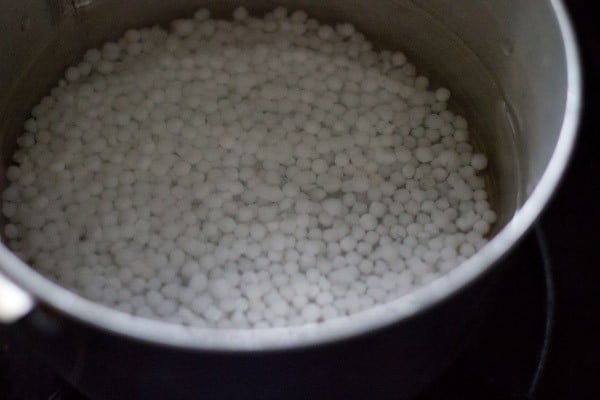
2. Place this pan on your stovetop and cook sabudana until you see the pearls starting to float on top. They loose their denseness and become light.
The opaqueness in the tapioca pearls gives way to translucency and they start swelling up. This takes about 5 to 6 minutes on low to medium heat.
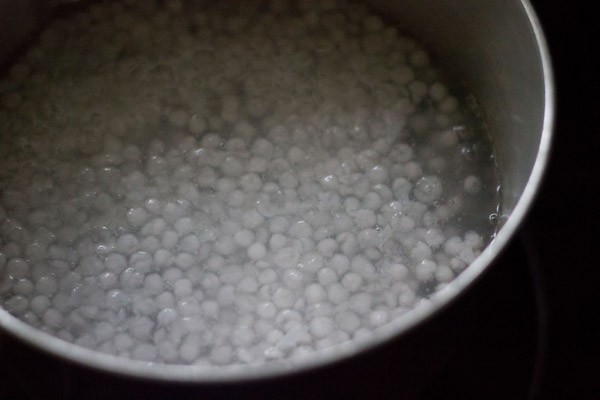
3. Next, add 2 cups whole milk, ½ teaspoon green cardamom powder and stir.
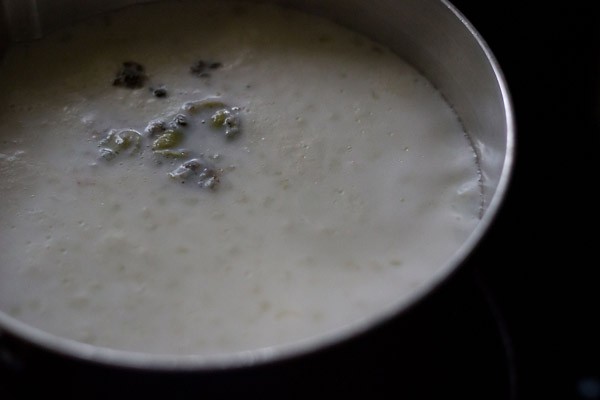
4. Add 4 to 5 tablespoons raw sugar or as needed according to your taste preferences. You can also add white granulated instead.
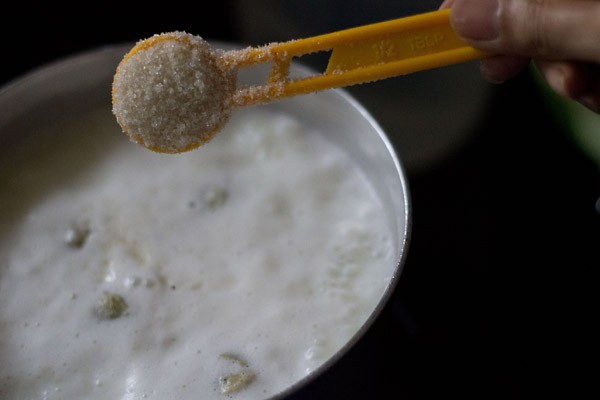
5. Continue to simmer till the sabudana pearls have softened well and the kheer has thickened. This takes about 20 to 25 minutes on low to medium heat.
Stir often, so that the kheer or sabudana does not stick to the bottom of the pan.
Some of the tapioca pearls would break too and also help in the thickening of the kheer.
These sago pearls are plain starch and this helps in the thickening. Turn off the heat and add cashews and raisins or choose to add your preferred nuts.
Check the taste and add more sugar if the kheer feels less sweet to you.
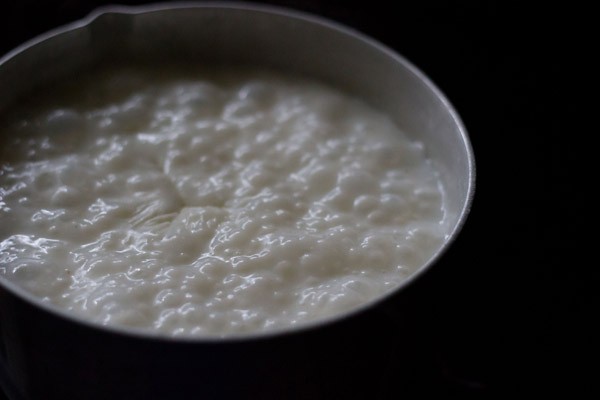
6. Serve the creamy Sabudana Kheer hot, warm or chilled. If you want, you can garnish the kheer with a few saffron strands or some chopped cashews.
Keep in mind that the consistency will thicken after cooling.
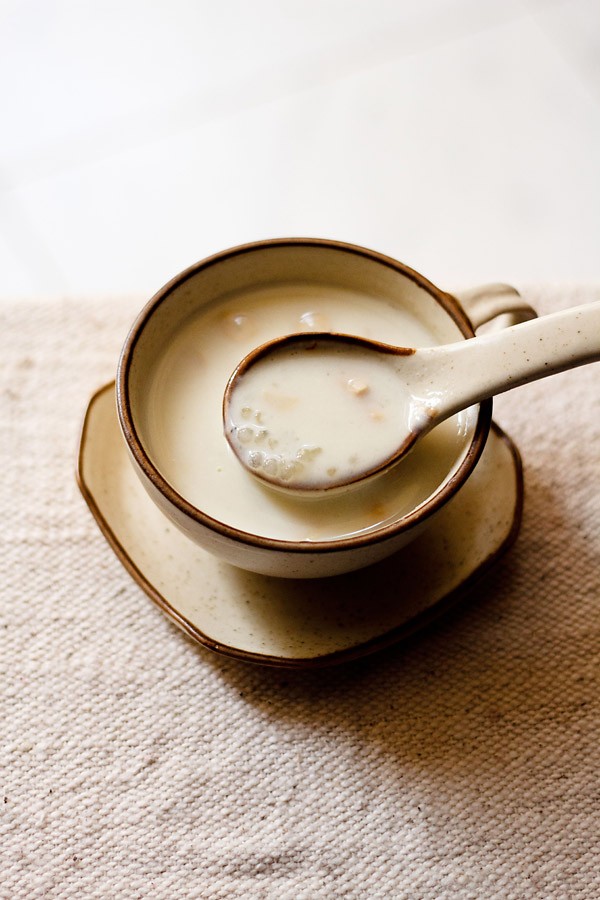
Serving Suggestions
You can serve or relish the flavors and texture of the Sabudana Kheer by serving it either hot or warm. It can also be refrigerated and served chilled. While serving, you can garnish the kheer with some more nuts.
Sago Kheer can be consumed on its own or served as a part of a satvik (no onion, no garlic) meal or platter.
Consistency
This Sabudana Kheer has a creamy and smooth consistency. To achieve this, just remember to cook the sabudana very well.
Once cooked, the sago pearls should not give you any resistance when you bite into them. Meaning, the pearls should not feel hard to your teeth.
Sago Kheer naturally thickens after cooling. So, keep in mind the consistency you want, in case you want to serve it cold.
You can adjust the consistency by adding more or less milk. For a slightly thin consistency add more milk and vice versa.
If the kheer becomes too thick, you can adjust the consistency by adding some milk to it while serving. Sabudana Kheer is easy to digest too.
What is Sabudana
Sabudana is also called as ‘sago’ or ‘tapioca pearls.’ These are small round shaped pearls made from the starch obtained from the roots of the cassava plant (yuca, tapioca). Hence, aptly named so as well.
In northern and western parts of India, these opaque white pearls are called ‘sabudana.’ In Kannada, it is known as ‘sabbakki;’ in Tamil, it is called ‘javvarisi;’ in Telugu, it is referred to as ‘saggubiyyam’ and in Malayalam, it is known as ‘chowari.’ It may have some more names depending upon which regional cuisine it is used in.
Sabudana is pure starch. Thus, it one of the quintessential ingredients that is a part of fasting food. Sago pearls are also gluten-free.
In addition to this luscious and creamy Sabudana Kheer, we make a lot of snacks with it like Sabudana Khichdi, Sabudana Vada, Sabudana Tikki, etc.
Expert Tips
- Soaking: My recipe does not call for soaking sabudana for hours. So, real handy, if you have forgotten to soak sabudana. But if you have time, then you can soak sabudana for 2 to 3 hours. Soaking sabudana will reduce the cooking time.
- Choose the right sabudana: For making Sago Kheer, use the regular sized sabudana available in the market. Do not use nylon sabudana which comes in large sizes as well as small sizes.
- Cooked sabudana texture: After cooking well, sabudana should be soft, slightly sticky and look translucent. They should not be dense, chewy or have any bite to them.
- Sweeteners: In place of sugar, you can add any sweetener. If using jaggery, palm sugar, palm jaggery or coconut sugar – when the kheer is done, place it on your kitchen counter-top for 4 to 5 minutes. This will cool it a bit. Then, add any of these grated or chopped sweeteners. Mix and serve.
- Flavorings: I always add green cardamom powder or saffron (kesar) in my kheer recipes. But you can experiment and add any vibrant floral flavors like orange extract, rose water, screw pine water, vanilla extract, ground cinnamon, lavender extract, or anything you fancy.
- Nuts: You can always add your choice of nuts and dry fruits. Choose almonds, walnuts, pine nuts, pistachios, dates, dried figs, chironji (charoli), etc. You can also skip adding the nuts or dry fruits altogether.
- Vegan option: Make the Tapiocal Pudding with almond milk. Follow these steps – first cook sabudana in water until softened completely. Add almond milk, sugar and gently simmer. Do not boil. Finish off with the nuts or dry fruits. Use the same method if adding coconut milk. Let the coconut milk become warm or get heated gently and do not boil.
- Storage: Refrigerate the leftover kheer for about 2 to 3 days in a covered container.
More Kheer Recipes To Try!
Navratri & Fasting Recipes
Navratri & Fasting Recipes
Navratri & Fasting Recipes
Please be sure to rate the recipe in the recipe card or leave a comment below if you have made it. For more vegetarian inspirations, Sign Up for my emails or follow me on Instagram, Youtube, Facebook, Pinterest or Twitter.
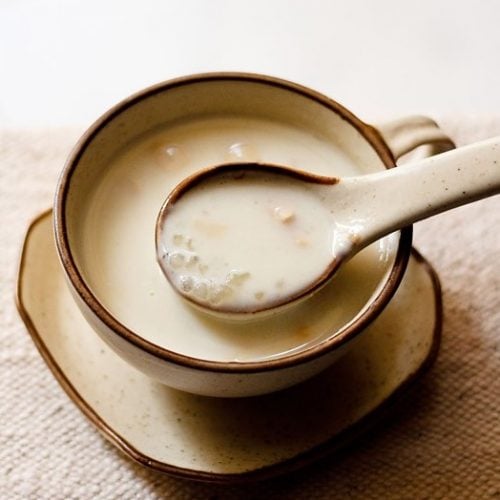
Sabudana Kheer | How to make Sabudana Kheer
Ingredients
- ½ cup sabudana or sago (tapioca pearls) – for a thicker kheer, you can add ⅔ cup of sabudana
- 2 cups water
- 2 cups whole milk
- 4 to 5 tablespoons sugar or raw sugar – add as required
- ½ teaspoon green cardamom powder or 4 to 5 green cardamoms crushed in a mortar-pestle
- 2 tablespoon cashews – chopped or preferred nuts
- ½ tablespoon raisins
- 3 to 4 strands of saffron – for garnish, optional
Instructions
Soaking Sabudana
- Rinse the sabudana pearls until the water runs clear of the starch.
- Take a thick bottomed pan or sauce pan in which you will be making the kheer.
- Add the rinsed sabudana pearls and water in the pan.
- Cover and let the pearls get soaked in the water for 15 to 20 minutes.
Making sabudana kheer
- Later keep this pan on the stovetop and begin to cook the sabudana pearls.
- Meanwhile heat or warm the milk too. No need to boil the milk.
- After 4 to 5 minutes, add the milk to the pan and continue to cook.
- Add sugar and green cardamom powder and simmer till the sabudana have cooked well and softened – for about 20 to 25 minutes on a low to medium heat.
- The sabudana pearls should be soft and look translucent after they are cooked really well. They should not be hard or dense or chewy. This means that they need to be cooked for some more time.
- Keep on stirring often so that the kheer or the cooked sabudana does not stick to the bottom of the pan.
- Turn off the heat and add cashews and raisins. Do a taste test and add more sugar if the kheer has a less sweet taste.
- Easily adjust the consistency of the kheer by adding less or more milk. Keep in mind that the consistency thickens on cooling.
- Garnish with a few saffron strands while serving.
- Serve Sabudana Kheer hot or warm or chilled.
Notes
- Soaking: You can opt to soak sabudana in water for 2 to 3 hours. Soaking sabudana reduces the cooking time of the kheer.
- Cooked sabudana texture: Sabudana should be soft, slightly sticky, and look translucent after they have been cooked really well. They should not be hard or dense.
- Choose the right sabudana: Use the regular-sized sabudana available in the market. Do not use nylon sabudana which comes in large size as well as small size.
- Nuts: You can always add your choice of nuts and dry fruits. You can even skip adding the nuts, dry fruits altogether.
- Flavorings: You can experiment and add any bright or floral flavors like orange extract, rose water, screw pine water, vanilla extract, lavender extract, cinnamon powder, or anything you fancy.
- Sweeteners: In place of sugar, you can add any sweetener. If using jaggery, palm sugar, palm jaggery, or coconut sugar, when the kheer is done, place it on your kitchen counter-top for 4 to 5 minutes. This will cool it a bit. Add grated or chopped jaggery, palm sugar, coconut sugar, or palm jaggery. Mix and serve.
- Vegan option: Follow these steps with almond milk – first cook sabudana pearls in water until they are completely softened. Add almond milk, sugar and gently heat to a slight simmer. Do not boil. Finish off with the cashews and raisins. If adding coconut milk, let it become warm or get heated gently and do not boil.
- Storage: Leftover kheer can be refrigerated for 2 to 3 days.
Nutrition Info (Approximate Values)
This Sabudana Kheer recipe post from the archives first published in September 2013 has been updated and republished on March 2023.
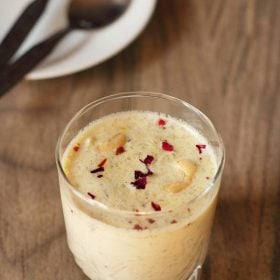
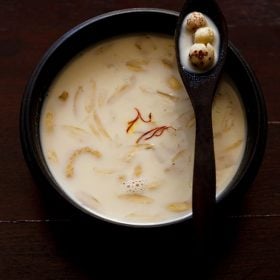
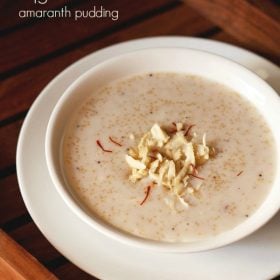
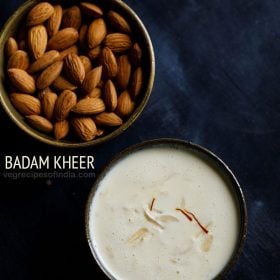

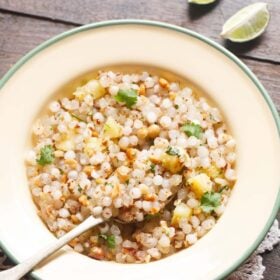

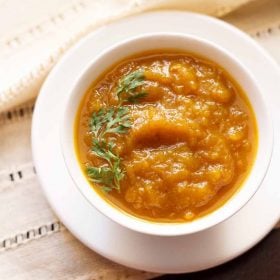








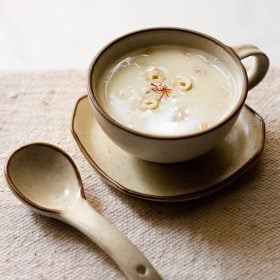
delicious !! love tapioca simple yet delish recipes !!
Thanks 😉
Thanks for this recipe, very simple, I am just preparing it. All the best mam
welcome shareena. i hope you like the sabudana kheer recipe. thank you.
I would like to simply in one sentence that your blog is like an encyclopedia of recipes. Whenever I wish to try new dishes I search for it in your blog in I get it . Thanks so much.
thank you sujata. i still have to add a few popular indian recipes. when they are added, then the blog will be almost complete in covering mainstream indian recipes. i felt good to read your comment, though. thanks again and most welcome. wish you all the best.
Very good ma’am
Thanks
thanks and welcome.
Hi,
What can I substitute cashews & raisins with?
you can use nuts and dry fruits like almonds, pistachios, chironji or charoli seeds. you can skip adding any nuts or dry fruits altogether.
Nice method of recipe
Can i drink this sabudana in my snack time at my office, is it good if i drink daily without milk only sabudana, water and sugar ingrediants.
anything of too much is never good. so i would suggest to have sabudana once in a while.
Hi, do we need to soak sabudana for 3 to 4 hrs? Or just 15 mins boiling is enough???
Deepika, if you soak sabudana for 3 to 4 hours then cooking time will reduce. you can do either of them. both method will work.
Hey Dassana, I love your recipes..I made sabudana tikki,sabudana kheer,farali pattice and sabudana khichdi following your instructions and let me tell you everybody at home loved it!! Thank you so much..wish i could post the picture here.
Welcome Sumedha. Glad to know this. Thanks for sharing positive feedback on sabduana recipes.
When do i add the sugar
when to add sugar is already mentioned in the recipe card as well as in the step wise pics.
Thank u so much for the easiest recipe…
It’s easy and fast to cook.
thanks for the recepie,i’ll definitely try it this week.I have a question though – before step 3,do you strain the cooked sabudana in the second step?
the sabudana is not strained after they are cooked.
Thanku so much for all ur recepies
it has survive me after my marriage and also after I became a mother.
Great help for newly wed
pleased to know this vaishali and thankyou for your positive words 🙂
Love u so much……u make cooking food easy
I watch all u r recipe
They simple…n easy to make
welcome bhavani and thankyou 🙂
send me latest recipes
nitika, your email has been added in recipes email subscription list.
So important guidance, thankyou so much.
welcome selvibaskar
Thnxz for ur recipes ……
It really helped me a lot in my fast(vrat)
welcome sunny. glad to know this.
hi Dassana,
Can this kheer be stored and refrigerated? Looks tempting.. Will try.
thanks garima. for one day you can keep in fridge. consume the kheer within one day. it will thicken. but don’t freeze it.
Sure. By the way, it turned out great. We all loved it.
thanks garima. glad to know this.
Awesome…tasty Kheer…all loved it…
Thanks Dassana…
welcome.
Hi Dassana
I always try your recipes but never get a chance to comment, but today i have to coz being a maharashtrian this recipe i tried for my hubbys tiffin and it came out deliciously delicious.
Thank you so much and I remembered my mom would make this.
All the readers should try this.
Thanks and tk cre
Lv sunita
thanks sunita. good to see you back. you too take care 🙂
thanx.. helped a lot 🙂
welcome nidhi
I just tried this recipe and its sooo yummy! totally loved it, i added cinnamon too, but the cardamom its the star of it all. i have to make this my everyday breakfast! Thanx a lot!
thanks lin for your feedback. in most indian sweets as well as puddings, cinnamon is not added. but in western sweets & desserts, cinnamon is usually added. personally, i have tried cinnamon in rice pudding and i agree it tastes good. but i also agree that cardamom steals the flavor 🙂
Kheer is very very tasty……….
thanks manju
Looks so creamy and delicious.. Yummy!